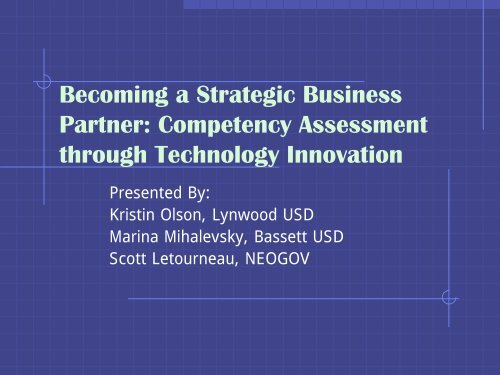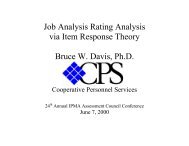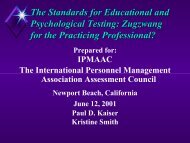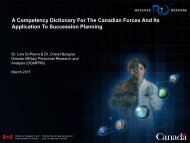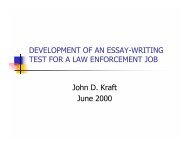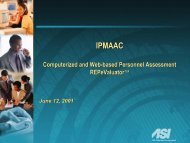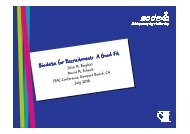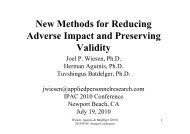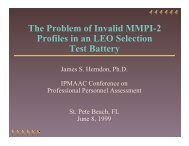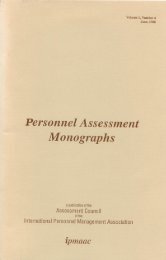Competency Assessment through Technology Innovation - IPAC
Competency Assessment through Technology Innovation - IPAC
Competency Assessment through Technology Innovation - IPAC
Create successful ePaper yourself
Turn your PDF publications into a flip-book with our unique Google optimized e-Paper software.
Becoming a Strategic BusinessPartner: <strong>Competency</strong> <strong>Assessment</strong><strong>through</strong> <strong>Technology</strong> <strong>Innovation</strong>Presented By:Kristin Olson, Lynwood USDMarina Mihalevsky, Bassett USDScott Letourneau, NEOGOV
Goal of this PresentationTo understand the strategic impact ofcompetency integrationTo outline competency implementationprocessTo understand competency & technologyintegrationTo answer questions in regard to this conceptand processPlease hold all questions to the end. (thankyou)
<strong>Competency</strong> DefinitionWHAT is a competency??• “…observable performance dimensions, including individualknowledge, skills, attitudes, and behaviors, as well ascollective team, process, and organizational capabilities, thatare linked to high performance, and provide theorganization with sustainable competitive advantage”(Arvy & Orth, 1999).Note:• Focuses on the observable allows metrics to bedeveloped for evaluation• Incorporates KSAs more holistic and inclusive• It is by definition strategic: adds value
The Battle: <strong>Competency</strong> VS. KSAHow do competencies move BEYONDKSAs??Incorporates the concept of:Strategic Total Personnel Managementat an Organizational LevelCompetencies move beyond the verydiscrete unconnected manner in whichKSAs are often used
Briefly: Difference betweenKSAs & CompetenciesTraditional KSAs are defined: very discrete, notconnected to anything, no promotional pathways, noperformance levels, the same KSAs that are in entrylevel positions are also in executive managementpositions! Example: ability to communicate orally, butto what extent and what is the level of performanceexpectation?Proposed competency framework defined:performance levels are clearly defined so thateveryone understands the level that employees areexpected to perform at establishes a much moreclearly defined work environment, eliminates roleambiguity, and creates promotional pathways!!
<strong>Competency</strong> Modeling FrameworkContinuum of progression withinmastery levels• Scope: parameters of operation• Context: environment of functioning• Autonomy: level of independence Clearly operationalizes expected behaviorsat the different mastery levels withincreasing difficulty and role responsibility
<strong>Competency</strong> Mastery LevelsCreation of Promotional Pathways:• number of mastery levels can vary depending onorganizational hierarchical structure and need<strong>Competency</strong>Mastery/Proficiency LevelLevel 1: Entry-levelDefinition:Conceptualizationand continuumof progressionLevel 2: Journey-levelLevel 3: Supervisory/ Mid-ManagementLevel 4: Management/ Sr. ManagementLevel 5: Sr. Management/Administrator
Competencies and Mastery LevelsMastery levels describe the degree ofcompetencyIncremental increase in proficiency asthe mastery levels increaseLevel 1 Level 2 Level 3Adheres to goalsand deadlines set bysupervisorSets goals andpriorities for own workto ensure deadlinesare met.Sets goals andpriorities for own workand coordinatesactivities and time-lineswith/for others.
Competencies &Strategic InterconnectednessMission &VisionJobDescriptionSelectionToolsGoal SettingRecruitmentOrganizationCulture<strong>Competency</strong>OrientationTrainingEmployeePromotionSuccessionPlanningCareerPlanningPerformanceEvaluationProfessionalDevelopment
Competencies: Total PersonnelManagement SystemHR cannot be wholly strategic until itoperates as an integrated and reinforcingsystem at an organizationally impactful level<strong>Competency</strong> integration creates anenvironment where the different functions ofHR can be interconnected AND observablyconnected to the organizational goals
<strong>Competency</strong> Integration:Strategies for SuccessSchoonover et al, 2000 found that employeesatisfaction levels are impacted by competencyimplementation strategies• Used more multi-dimensional criteria in theirmodels: mastery levels• Implemented competencies across moreorganizational levels and across more functions:Were designing and implementing morecomprehensive performance and developmentfeedback systems.• Were enabling their competency applications<strong>through</strong> technology to a greater extent
Competencies:Total Personnel Management SystemCompetencies allow you to beorganizationally strategic:• Can connect competencies to theorganizational mission and goals:IMMEDIATELY you are observably showinghow HR adds value and is viable at anorganizationally wide level: are selectingand bringing in employees that will help anorganization achieve its goals
Competencies: Total PersonnelManagement SystemScenario: an employee is selected andthen sent off into the organization: thisprocess is not interconnected with otherHR functions and is not strategicNeed to ask how does this add value:the organization is being provided witha body, but most anyone can do thiswith some training
Competencies: Total PersonnelManagement SystemINSTEAD: use of competencies can connectselection to classification to performanceexpectations AND all this information can bepulled directly from the class spec in the formof mastery levels• NOW: <strong>through</strong> use of competencies performancemanagement is integrated with the classificationand selection process• The employee knows what is expected of them• The manager knows what is expected of the employee
Competencies: Total PersonnelManagement SystemHow can we connect this even further andcreate a Total Personnel Management Systemat an even more fully developed level?Answer: TrainingTraining programs can be developed basedon the different competency mastery levels(i.e., performance expectations) which are onthe class spec
Competencies: Total PersonnelManagement SystemWhat does integration of training allow?• It provides employees with the tools they need tosucceed as employees• It provides mangers with the tools they need tosucceed as mangers: train employees so they are atthe level they need to be at• Taking this another step further: the training enablesmangers and employees to take ownership of thisprocess• Adding value: setting the organization up for successby creating an environment where competencyexpectations are visible to all organizational membersand organizational structures are in place to achievedesire performance levels
Competencies: Total PersonnelManagement SystemStrategic impact of competency training• Think about all the retirements that arepending…• <strong>Competency</strong> training enablesorganizationally built in successionplanning!• AND it is more cost efficient to developemployees internally
Competencies: Total PersonnelManagement SystemNow, can we take this another step and integrate HRprocesses even further becoming more integratedand strategic?YES: evaluation metrics can be added into thissystem creating an environment of constantfeedback, evaluation and improvement• Example: evaluate the employee on performanceexpectations in the mastery level that is connected to theorganizational mission “customer service”, see a skill gap,send them to training, re-evaluate, make adjustments asneeded: set employee up for success b/c you provided themwith the missing skill, set the org up for success b/c you arehelping them provide a valued service
How do Competencies Add Value:HR as a Strategic Business PartnerClassification Strategic Impact Summary:Job Descriptions: are more well defined,greater role clarity, able to understandperformance level better (both managers andemployees)Impact statements:Employees become more than a number in anorganization, understand their role andcontribution in the organization, and how andwhere they specifically fit into the organizationCore competencies should be connected to theorganization mission and values
How do Competencies Add Value:HR as a Strategic Business PartnerRecruitment Strategic Impact Summary:Helps to target recruitment, know the specific skill setyou are looking for, example: do you need to lookoutside the organization or can you develop someonein the organization <strong>through</strong> use of the promotionalpathways and targeted training• Better RJP and self-selection• Decrease in administrative workSelection Tools Strategic Impact Summary:Modular testing on the different competencies: evenmore strategic to create parallel sets of modular tests
How do Competencies Add Value:HR as a Strategic Business PartnerTraining Programs Strategic Impact Summary:Based directly on the competencies, even morestrategic: create different levels of training based onthe mastery levels enables to an organization todevelop internal training academies (competencyenhancement)Creates a sense of ownership of career planning byemployees as they can select different levels ofcompetency trainingOrientation training: able to training incomingemployees on the core organizational values/corecompetencies, can help with employee retention:immediately understand the organizational valuesand expectations
How do Competencies Add Value:HR as a Strategic Business PartnerPerformance Evaluation & ManagementStrategic Impact Summary:Connect the selection instrument to theperformance evaluation: criterion validation,enhances legal defensibilitySuccession Planning & Promotion StrategicImpact Summary:Helps with employee retention and employeedevelopment, create internal trainingprograms based on competencies, addressproductivity losses in this manner
How do Competencies Add Value:HR as a Strategic Business PartnerAll of these initiatives jointly create an interconnectedhuman resources management system that:• Shows you value employees• Create a system of continuous evaluation andtherefore system improvement• Create a culture of continuous learning• Able to maximize employee skills set via training• Enhances legal defensibility of instruments• ALL of this jointly enhances cost efficiency andvalue: thus HR becomes a strategic businesspartner <strong>through</strong> competency integration
DEVELOPINGCOMPETENCY MODELS
Approaches in Developing<strong>Competency</strong> Models“Bottom-Up” Method• Criterion Sampling• Superior performers• Average performers – form a baseline measure• Behavioral-Event-Interviewing (BEI)– created byDaniel McClelland• Variation of a critical incident technique (Flanagan, 1954)• Gathering information on responses/behaviors incritical/challenging situations either <strong>through</strong>individual/focus group interviews• HR expert conducts content analysis to delineate criticalbehaviors that differentiate superior versus averageperformers
“Bottom-up” Approach Drawbacks• Inadequate criterion sample• Need for Qualified Staff – internal staffingmay not be available requiring outsourcingto a consultant• Time consuming• May be disruptive to the workforce• Requires time away from the job, which results inlost productivity of the group -> additional financialcost
Approaches in Developing<strong>Competency</strong> Models“Top-down”• Essential Competencies are identified byHR professionals w/ feedback frommanagement• <strong>Competency</strong> models from otherorganizations are adopted based on jobcomparison
Examining JA & CM PracticesSchippman et al., (2000)• CM practices lack rigor and standardization• Only advantage is that they link tobusiness strategy and goals• Recommendation: capitalize on jobanalysis methodology to create uniformityin competency model development
Capitalizing on Job AnalysisLack of empirical literature on evaluatingcompetency modeling methodology withregard to accuracy and reliability of ensuingcompetency profilesNeed to capitalize on decades of empiricalresearch in the job analysis domainexamining factors impacting accuracy andreliability of job analytic data
Factors Impacting RatingAccuracy & Reliability• Rater Type: incumbent vs. supervisor• Incumbents inflate/deflate ratings based on self-servingbiases: impression management• Job Knowledge: employee tenure• Experience employees provide more accurate job ratings• Recent research finding: profession tenure versus jobtenure is more predictive of rater accuracy• Amount of job descriptive information• (Harvey et al, 1988; Lievens et al, 2004)• Organizational mission statement, values andgoals (Lievens et al, 2004)
Need for Structure in<strong>Competency</strong> Modeling MethodsBiases in Cognitive Judgment• Morgenson et al (2004)Findings:• ability statements are more subject to inflationthan task statements across all rating scales• frequency and importance ratings of globalcompetency statements were generally higherthan decomposed ability and task scales, butrequired-at-entry job requirements judgmentsdemonstrated the opposite relationship.
Research ImplicationsDrawing on JA research:• the cognitive task of rendering judgments aboutcompetency and competency proficiency levelswould seemingly not only parallel in complexity toa task of identifying ability requirements, but issubject to an even larger abstract inferential leapsin the judgment process.Recommendation: breakdown of a complexjudgment process into a series of concretemanageable steps helps to diminish theinferential leaps involved in determining ajob’s competency requirements
Alternative <strong>Competency</strong> Framework SampleHandling Stress: Maintains composure in the face of highworkload, competing or conflicting demands, ambiguousassignments, interruptions and distractions. Maintains focusand emotional control in stressful interpersonal situations and inunpleasant or extreme environments.Indicate how relevant the competency is to performingessential job functions successfully:(1) Not at all Relevant (3)Somewhat Relevant (5) Extremely RelevantClassification Title:Human Resources GeneralistHuman Resources Director
STRESS MANAGEMENT
WEB-BASED COMPETENCYASSESSMENT QUESTIONNAIRERater Objective: evaluate each competency onthe following scales:Need for <strong>Competency</strong> Scale: Please assess the relevancy ofthe given competency in performing essential/critical jobfunctions.<strong>Competency</strong> Level: Please indicate the minimal level ofcompetency mastery/proficiency that is required at jobentryin order to perform successfully on the job of aPersonnel Director.<strong>Competency</strong> Value: Please indicate to what extent a givencompetency contributes value to differentiating betweensuperior performances in comparison to minimallyqualified performance on the job.
<strong>Competency</strong> Models/ProfilesForced Distribution• Once the rater renders judgments, thepreliminary “essential” tasks are onceagain reviewed to select a narrow range ofcompetencies to be designated as“essential”• <strong>Competency</strong> Models should range from:• 5-15 competencies depending onclassification• Fewer competencies requirements for entrylevelclassification
Developing <strong>Competency</strong> Models: Key PointsDevelop/Adopt a Framework that adequatelymeets organizational needs• How extensively will you be implementingcompetency models?• ie. few select HR functions or whole-systems approachDevelop/Adopt Methodology w/ sufficientrigor and standardization to achieve accuracyin competency requirement judgments• Cannot develop effective HR programs if thefoundation is flawed (ie. competency models lackconsistency, accuracy and reliability)
Capitalizing on <strong>Technology</strong> <strong>Innovation</strong>
Using <strong>Technology</strong> to Enable Competencies<strong>Competency</strong> Anatomy<strong>Competency</strong> BankCreate Selection ToolCreate Performance <strong>Assessment</strong>sConduct Criterion ValidationMeasure Training EffectivenessTrack Certification and TrainingOrganize Succession PlanningBecome More Strategic
<strong>Competency</strong> AnatomyClassSpecificationPerformance<strong>Assessment</strong><strong>Competency</strong>TrainingSelectionToolWritten ItemOral InterviewItem
<strong>Competency</strong> Bank<strong>Competency</strong> BankTI Q1TI Q2CoreCompMasteryLevelTrain 1Train 2C1C2C3T1T2BI1BI2• TI Q: Test Item• Train: Required Trainings• BI: Behavioral Indicator<strong>Competency</strong> Bank contains:• All Core & Technical Competencies• Selection Tool Test Items• Required Certificates and Trainingsbased on each Mastery Level• Behavioral Indicators based oneach Mastery Level
Create Selection ToolCoreComp 1MasteryLevel 3CoreComp 2MasteryLevel 4TI Q1TI Q2TI Q1TI Q2Selection Tool:C1-ML3-TI1C1-ML3-TI2C1-ML4-TI1C1-ML4-TI2How to Create• Decide on selection tool(written, oral, T & E, etc.)• Based on the ClassSpecification competenciesand corresponding masterylevels, go into thecompetency item bank andselect the appropriate testquestions
Create Performance <strong>Assessment</strong>CoreComp 1MasteryLevel 3BI1BI2Performance<strong>Assessment</strong>:C1-ML3-BI1C1-ML3-BI2C1-ML4-BI1C1-ML4-BI2CoreComp 2MasteryLevel 4BI1BI2How to Create• Based on the ClassSpecification competenciesand corresponding masterylevels, go into the competencyitem bank and select theappropriate behavioralIndicators
Criterion ValidationCoreComp 1MasteryLevel 4BI1SelectionToolBI2TI Q1TI Q2Performance<strong>Assessment</strong>CoreComp 1MasteryLevel 4BI1BI2Goal is to obtain validity estimatesby examining the relationshipbetween selection tool test itemswith the behavior indicators of theon the job performance results.Report would show the relationshipbetween competency scores onboth selection tool andperformance assessment <strong>through</strong>regression analysis
Training EvaluationClassSpecificationPerformance<strong>Assessment</strong>C1 – ML3Training<strong>Competency</strong>C1 – ML4Mastery level should increaseGoal is to validate that trainings increase the on the job behaviorindicators for required mastery levels. Report would show changeresults of behavioral indicators for particular mastery levels comparedwith the completed training.
Performance <strong>Assessment</strong> IndicatorsCriterion Validation1) Selection Tool Test Item results CORRESPOND with On the JobBehavioral Indicators in the Performance <strong>Assessment</strong>Training Validation2) On the Job Mastery Level Behavior Indicators in thePerformance <strong>Assessment</strong> INCREASE as a result of attendingTrainings
Succession PlanningHR DirectorC1 – ML 5C2 – ML 5T1 – ML 5HR SpecialistC1 – ML 4C2 – ML 3T1 – ML 5Personnel Analyst IIC1 – ML 3C2 – ML 3T1 – ML 5Challenge• How to track whatcompetencies your currentemployee base possesHR Admin IC1 – ML 1C2 – ML 2T1 – ML 2HR Admin IC1 – ML 2C2 – ML 2T1 – ML 2• How to structure create anddefine succession plan(needs analysis incompetencies, training, andcertifications)
Succession Plan1) Report of needs analysis ofcomps and MLs2) Comps and MLs are tied totrainings and certificationsResults are:• HR Specialist needs• C1-ML4-ML5, which requirestraining A• C2-ML3-ML5, which requirestraining C and DHR Admin IC1 – ML 1C2 – ML 2T1 – ML 2HR SpecialistC1 – ML 4C2 – ML 3T1 – ML 5HR Admin IC1 – ML 2C2 – ML 2T1 – ML 2HR DirectorC1 – ML 5C2 – ML 5T1 – ML 5Personnel Analyst IIC1 – ML 3C2 – ML 3T1 – ML 5• PA II needs• C1-ML3-ML5, which requirestraining A and B• C2-ML3-ML5, which requirestraining C and D** Competencies allow you to do truesuccession planning, above anbeyond recruitment planning
RecapCriterion ValidationEffectively identify selection tools and items are / are not good indicatorsof actual job performance (TI : BI)** Employees do not need to know “how” to do criterion validation, they justrun the reports and the statistics determine the validity results.Training EffectivenessAccurately identify which agency trainings have a positive / negative / noimpact on employee growth and competency enhancement (BI fromperformance <strong>Assessment</strong> : Train)Succession PlanningQuickly establish a succession plan detailing what competencies,trainings, and certificates are required for every employee to move toevery position within the agency (i.e., a Clerk Typist I to become Directorof Public Works and determine the path and timing of how they can getthere)
Strategic OrganizationsRecruitment, Selection/Testing, Validation, Planning = Strategic OrganizationRecruitmentSelection/Testing/HiringPerformance Training /Evaluations CertificationsSuccessionPlanningResults:Time Effort Cost Service Satisfaction Retention
Contact InformationKristin Olson, Lynwood USD• Email: kolson@lynwood.k12.ca.us• Phone:Marina Mihalevsky, Bassett USD• Email: mmihalevsky@bassett.k12.ca.us• Phone: 626.931.7982Scott Letourneau• Email: scott@neogov.com• Phone: (888) NEOGOV1 x 203


